What’s Up for September? The Moon with Mars and Venus, and a star with a planet…that wasn’t.
On September 6th, you’ll find the Moon extremely close to Mars in the predawn sky. Now, they were even closer back on August 9th, but still a really pretty spectacle this month. If you’re up early and can step outside for a look, they’ll be only a couple of degrees apart, meaning they’ll appear in the same field of view if you take a look with most binoculars.
On September 13th and 14th, look in the east before dawn to see the slim crescent Moon slip past brilliant Venus. On the 13th you’ll find the Moon hanging above Venus with about 20 percent of its surface illuminated. By the next morning, the Moon has moved here, to the left of Venus, and has only about 10 percent of its sunlit surface visible.
Looking toward the south in September, there’s really only one relatively bright star for most of us who live near cities. That star is called Fomalhaut, and it’s got a pretty interesting story. The star is about 25 light years away, meaning it’s relatively close by. It’s also fairly young, at just a few hundred million years, and it’s still surrounded by a disk of debris, which is a common feature for stars during their planet-forming phase. Now we’ve discovered thousands of exoplanets – planets outside our solar system – but Fomalhaut appeared to be the first star to have a planet detected by direct imaging with a telescope (that being the Hubble Space Telescope). Astronomers announced the find back in 2008.
So Fomalhaut had itself a planet! But this is where it gets interesting, as the “planet” had a funky orbit, wasn’t giving off excess heat like a young planet should, and proceeded to grow fainter over the several years that followed, disappearing by 2014. In April 2020, another team of astronomers using Hubble announced their finding that Fomalhaut’s “planet” wasn’t a planet after all. In fact, their study showed what Hubble detected was likely a giant, expanding cloud of debris resulting from a huge collision of two small bodies made of dust and ice, similar to worlds you might find in our own Kuiper Belt.
The scientists calculate collisions like this happen around Fomalhaut only every couple hundred thousand years, so Hubble just happened to be looking at the right time, not long after the collision took place.
So we may have lost a planet, but we gained a cool insight into how planetary systems form and evolve. You can find Fomalhaut low in the south a couple of hours after sunset, to the left of the bright pair of Saturn and Jupiter. Since it’s bright and low in the sky, it sometimes appears to flicker from atmospheric turbulence. That can cause some skywatchers to wonder just what the heck it is. Now you know: it’s Fomalhaut, the nearby star where it appears we witnessed a dramatic planetary collision.
Here are the phases of the Moon for September.
Daily Guide
August 28-30
On Friday night into Saturday morning, August 28 to 29, 2020, the bright planet Jupiter will appear near the waxing gibbous Moon, with the fainter planet Saturn appearing nearby. As evening twilight ends (at 8:44 p.m. EDT for the Washington, DC area), the Moon will appear in the south-southeast about 24 degrees above the horizon, with Jupiter appearing about 2 degrees above the Moon, and Saturn appearing about 9 degrees to the left. The Moon will reach its highest in the sky for the night at 9:55 p.m., appearing in the south about 26 degrees above the horizon. Jupiter and the Moon will set together in the west-southwest Saturday morning at 2:38 a.m., with Jupiter on the right and Saturn above the Moon.
Saturday evening, August 29, 2020, will be (for the Washington, DC area, at least) the first evening when Mercury will be above the horizon about 30 minutes after sunset, an approximation of when it will start being visible in the evening sky.
Saturday evening into Sunday morning, August 29 to 30, 2020, the planet Saturn will appear near the waxing gibbous Moon, with the brighter planet Jupiter appearing nearby. For the Washington, DC area, as evening twilight ends at 8:42 p.m. EDT, the Moon will appear in the south-southeast about 21 degrees above the horizon, with Saturn appearing to the upper right of the Moon and Jupiter appearing farther to the right. The Moon will reach its highest in the sky for the night at 10:49 p.m. and Jupiter will set first in the west-southwest Sunday morning at 2:34 a.m.
Even though they are not usually visible, I include in these Moon missives information about near-Earth objects (mostly asteroids) that may pass Earth within five lunar distances, because I find it interesting that we have discovered so many. Sometime in late August or early September 2020 (2020-Sep-01 16:12 UTC with 8 days, 8 minutes uncertainty), a near earth object (2011 ES4), between 73 to 162 feet (22 and 49 meters) across, will pass the Earth at between 0.2 and 41.2 lunar distances (nominally 0.3), traveling at 18,260 miles per hour (8.16 kilometers per second).
September 1
On the evening of September 1, 2020 (the evening before the full Moon), as evening twilight ends (at 8:37 p.m. EDT for the Washington, DC area), the bright planet Jupiter and the fainter planet Saturn will appear in the south-southeast, with Jupiter to the right about 27 degrees above the horizon and Saturn on the left about 26 degrees above the horizon. The planet Mercury will have already set, but might be visible earlier in the evening (about 30 minutes after sunset), low on the western horizon. The bright star appearing almost exactly overhead will be Vega, the brightest of the stars of the “Summer Triangle,” appearing 86 degrees above the eastern horizon. The other bright stars of the Summer Triangle are Deneb, which will appear about 62 degrees above the horizon in the east-northeast, and Altair, which will appear about 53 degrees above the horizon in the southeast. If you are one of the approximately 20 percent of the American population living away from city lights, you might be able to see the Milky Way running across the sky from south-southwest to north-northeast after the sky darkens to full nightfall. As the lunar cycle progresses, the background of stars and planets will appear to shift toward the west, while Mercury will remain near the horizon, gradually shifting from the west toward the west-southwest, and setting before evening twilight ends. Beginning September 28, 2020, the planet Mars will be above the horizon in the east as evening twilight ends. By the evening of full Moon after next on October 1, 2020, as evening twilight ends (at 7:47 p.m. EDT for the Washington, DC area), bright Jupiter will appear in the south about 28 degrees above the horizon with Saturn to the left of Jupiter at about 29 degrees above the horizon. Mars will appear in the east at about 2 degrees above the horizon. The Summer Triangle of Vega, Deneb, and Altair will appear directly overhead.
September 2
On the morning of the full Moon on Wednesday, September 2, 2020, as morning twilight begins (at 5:39 a.m. EDT for the Washington, DC area), the bright planet Venus will appear in the east about 29 degrees above the horizon. The planet Mars will appear in the southwest about 52 degrees above the horizon. The bright stars of the Summer Triangle will be setting in the northwest. The star appearing closest to overhead will be Capella, appearing 67 degrees above the horizon toward the east-northeast, with Aldebaran a close second at 62 degrees above the horizon toward the southeast. Capella, at 42.9 light-years from Earth, and Aldebaran at about 65 light-years, are both part of the local arm of our home galaxy, called the Orion-Cygnus Arm, which includes the brightest of the stars in our skies, Sirius (at 8.6 light-years from Earth), which will appear about 16 degrees above the horizon in the southeast. As the lunar cycle progresses, the background of stars will appear to shift toward the west. By the morning of the full Moon after next (Thursday, October 1, 2020), as morning twilight begins (at 6:07 a.m.), the bright planet Venus will appear in the East about 27 degrees above the horizon near the bright star Regulus (Venus and Regulus will appear at their closest on the mornings of October 2 and 3, 2020). The planet Mars will appear in the west-southwest at 26 degrees above the horizon. The constellation Orion will appear about 50 degrees above the horizon in the south, with the bright stars of the Orion-Cygnus Arm of our home galaxy spread from the south-southeast toward the northwest.
As mentioned above, the next full Moon will be early on Wednesday morning, September 2, 2020.
September 4
The morning of Friday, September 4, 2020, will be when the planet Venus appears at its highest above the horizon for this apparition (29 degrees for the Washington, DC area) at the time morning twilight begins. Because the angle of the line between the Sun and Venus and the line of the horizon is becoming more perpendicular, the date when Venus is highest above the horizon as morning twilight begins is not the same date as when Venus and the Sun appear farthest apart as seen from Earth.
September 5
On Saturday night into Sunday morning, September 5 to 6, 2020, the planet Mars will appear quite near the waning gibbous Moon. For the Washington, DC area, the Moon and Mars will rise together in the east at about 9:30 p.m. EDT, with Mars about a degree to the left of the Moon. After midnight the pair will appear closest to each other, with Mars appearing above the Moon. The Moon will reach its highest in the sky on Sunday morning at 4:01 a.m., with Mars appearing 1.5 degrees to the right. Morning twilight will begin around 5:43 a.m., with Mars appearing about 2 degrees to the lower right of the Moon. From parts of southeastern South America and Antarctica, the Moon will pass in front of Mars.
September 6
Early Sunday morning, September 6, 2020, at 2:31 a.m. EDT, the Moon will be at apogee, its farthest from Earth for this orbit.
September 8
On Tuesday midday, September 8, 2020, at about 11:54 a.m. EDT (2020-Sep-08 15:54 UTC with 19 minutes uncertainty), a near-Earth object (2020 PT4), between 91 to 204 feet (28 and 62 meters) across, will pass the Earth at between 4.9 and 5.0 lunar distances (nominally 4.9), traveling at 28,090 miles per hour (12.56 kilometers per second).
September 9-10
Tuesday night into Wednesday morning, September 9 to 10, 2020, the bright star Aldebaran will appear to the lower left of the waning gibbous Moon. For the Washington, DC area, Aldebaran will rise in the east-northeast at 11:32 p.m. EDT, appearing about 8 degrees from the Moon. The pair will appear to shift gradually closer together until Aldebaran is lost in the glow of dawn on Wednesday morning, with morning twilight beginning at 5:46 p.m.
Thursday morning, September 10, 2020, the waning Moon will appear half-full as it reaches its last quarter at 5:26 a.m. EDT.
September 11
Although not visible without a telescope, Friday, September 11, 2020, will be when the planet Neptune will appear at its closest and brightest for the year, opposite from the Sun as seen from Earth.
September 13
On Sunday morning, September 13, 2020, the bright star Pollux (one of the twins in the constellation Gemini) will appear about 5 degrees to the upper left of the waning crescent Moon. For the Washington, DC area, the Moon will rise in the east-northeast at 2:04 a.m. EDT and will be about 40 degrees above the horizon in the east at the time morning twilight begins at 5:50 a.m..
September 14
On Monday morning, September 14, 2020, the bright planet Venus will appear about 4 degrees to the right of the waning crescent Moon. For the Washington, DC area, Venus will rise in the east-northeast at 3:16 a.m. EDT, and the pair will appear about 28 degrees above the eastern horizon as morning twilight begins at 5:51 a.m..
September 15
On Tuesday morning, September 15, 2020, the bright star Regulus will appear about 6 degrees below the waning crescent Moon. For the Washington, DC area, Regulus will rise in the east-northeast at 4:56 a.m. EDT and morning twilight will begin at 5:52 a.m..
September 17
Thursday, September 17, 2020, at 7 a.m. EDT, will be the new Moon, when the Moon passes between Earth and the Sun and will not be visible from Earth.
The day of, or the day after, the New Moon marks the start of the new month for most lunisolar calendars. The eighth month of the Chinese calendar starts on Thursday, September 17, 2020 (at midnight in China’s time zone, which is 12 hours ahead of EDT). In the Islamic calendar the months traditionally start with the first sighting of the waxing crescent Moon after the New Moon, although many Muslim communities now follow the Umm al-Qura Calendar of Saudi Arabia, which uses astronomical calculations to start months in a more predictable way. Using this calendar Safar (the second month of the year) begins at sunset on Thursday, September 17, 2020. Other Islamic calendars may differ, as there are several different religious or national committees and organizations that make independent determinations of when the crescent Moon is first observed and the new month starts. Sundown on Friday, on September 18, 2020, marks the start of Tishrei in the Hebrew calendar. The first and second days of Tishrei are Rosh Hashanah, the head of the year or the Jewish New Year. Rosh Hashanah is the first of a series of holidays, with the tenth day of Tishrei being Yom Kippur and the fifteenth day of Tishrei (close to the full Moon after next) being the start of Sukkot.
September 18
On Friday morning, September 18, 2020, at 9:44 a.m. EDT, the Moon will be at perigee, its closest to the Earth for this orbit.
Sometime around Friday, September 18, 2020 (2020-Sep-18 21:32 UTC with 2 days, 6 hours, 16 minutes uncertainty), a near-Earth object (2014 QJ33), between 159 to 355 feet (48 and 108 meters) across, will pass the Earth at between 2.8 and 23.5 lunar distances (nominally 11.4), traveling at 18,530 miles per hour (8.28 kilometers per second).
On Friday evening, September 18, 2020, if you have a very clear view of the horizon in the west, you might be able to see the planet Mercury appearing to the lower left of the thin, waxing crescent Moon. The bright star Spica will appear farther to the left of Mercury. This may be hard to see without binoculars. The sky will probably not be dark enough to see Mercury and the Moon until the Sun has been down for at least 30 minutes (for the Washington, DC area, after about 7:41 p.m. EDT). Mercury will set about 18 minutes later (at 7:59 p.m.). Evening twilight won’t end until 19 minutes after that (at 8:08 p.m.) and the Moon will set 11 minutes after that (at 8:19 p.m.). Please be sure not to use binoculars or a telescope to look for these objects until after the Sun has set!
September 22
Tuesday morning, September 22, 2020, at 9:31 a.m. EDT, will be the autumnal equinox, the astronomical end of summer and start of fall. Somewhere on the equator the Sun will pass exactly overhead.
Tuesday evening, September 22, 2020, if you have a clear view of the horizon in the west-southwest, you might be able to see the bright star Spica appear just below the planet Mercury. You will probably not be able to see them until at least 30 minutes after sunset (after 7:34 p.m. EDT for the Washington, DC area), when Mercury will be only about 3 degrees above the horizon. Spica will set about 16 minutes later (at 7:50 p.m.) and Mercury will set about 4 minutes after Spica (at 7:54 p.m.), so this will be difficult to see and have a narrow window of time in which to look for it.
Also that night, the bright star Antares will appear about 8 degrees to the lower right of the waxing crescent Moon. For the Washington, DC area, evening twilight will end around 8:02 p.m., when the Moon will appear 22 degrees above the southwestern horizon. Antares will set in the southwest before the Moon at about 9:57 p.m.
September 23
On Wednesday evening, September 23, 2020, the Moon will appear half-full as it reaches its first quarter at 9:55 p.m. EDT.
September 24-25
On Thursday evening until after midnight on Friday morning, September 24 to 25, 2020, the bright planet Jupiter will appear about 5 degrees to the upper left of the waxing gibbous Moon, with the planet Saturn appearing farther to the left. From the northern hemisphere they will appear in the south as evening twilight ends. For the Washington, DC area, evening twilight will end at 7:59 p.m. EDT with the Moon 26 degrees above the horizon, and the Moon will set first in the west-southwest on Thursday morning at 12:35 a.m.
September 25-26
On Friday evening into early Saturday morning, September 25 to 26, 2020, the waxing gibbous Moon will have shifted to the east from the night before, appearing about 4 degrees to the lower left of the planet Saturn, with the bright planet Jupiter appearing farther to the right. For the Washington, DC area, the Moon will appear 26 degrees above the horizon in the south-southeast as evening twilight ends at 7:57 p.m. EDT, the Moon will be at its highest for the night (27 degrees above the horizon in the south) at 8:46 p.m., Jupiter will set first in the west-southwest on Saturday morning at 12:48 a.m., Saturn next at 1:25, a.m., and the Moon last at 1:35 a.m.
October 1
Thursday, October 1, 2020, will be when the planet Mercury reaches its greatest angular separation from the Sun as seen from Earth for this apparition (called greatest elongation), appearing half-lit through a large enough telescope. Because the angle of the line between the Sun and Mercury and the horizon changes with the seasons, the date when Mercury and the Sun appear farthest apart as seen from Earth is not the same as when Mercury will appear highest above the horizon in the west-southwest 30 minutes after sunset (an approximation of when it might be dark enough to see Mercury), which occurred earlier in September.
Sometime in late September or early October 2020 (2020-Oct-01 14:59 UTC with 6 days, 17 hours, 18 minutes uncertainty), a near-Earth object (2001 GP2), between 36 to 81 feet (11 and 25 meters) across, will pass the Earth at between 0.4 and 14.3 lunar distances (nominally 6.1), traveling at 4,950 miles per hour (2.21 kilometers per second).
As mentioned above, the full Moon after next will be on Thursday evening, October 1, 2020. This will be the Harvest Moon, the Chinese Mid-Autumn Festival, and one of the smallest full Moons of the year (the opposite of a supermoon, sometimes called a micro full Moon).

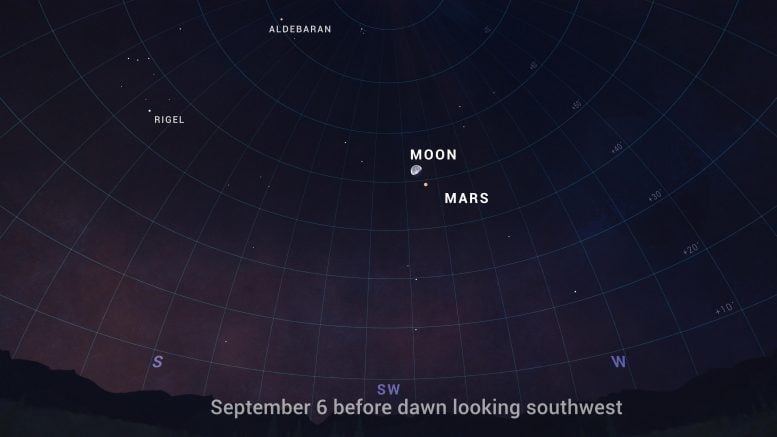
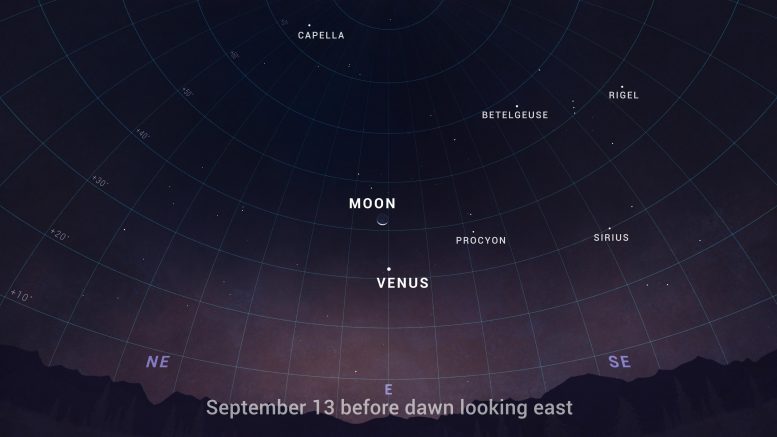
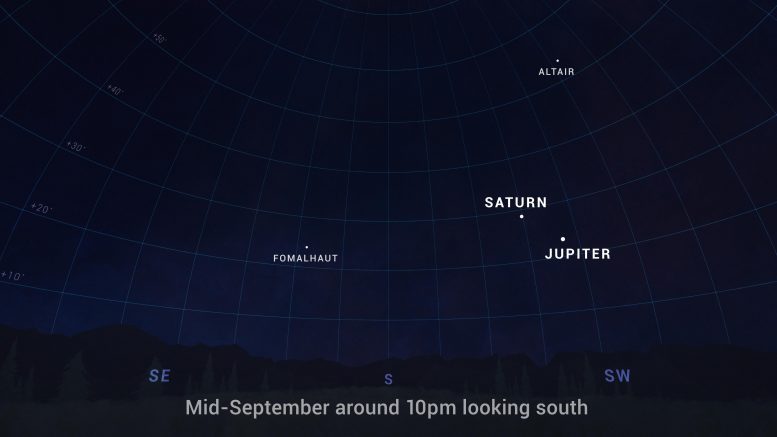
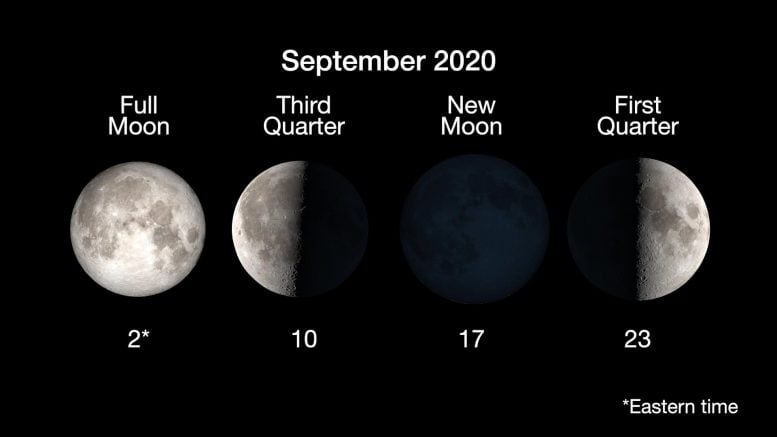

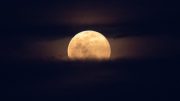
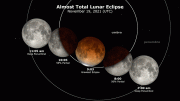

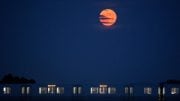


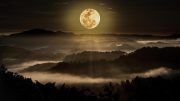
Be the first to comment on "September 2020 Skywatching Tips From NASA – Mars, Venus and a Star With a Planet…That Wasn’t"